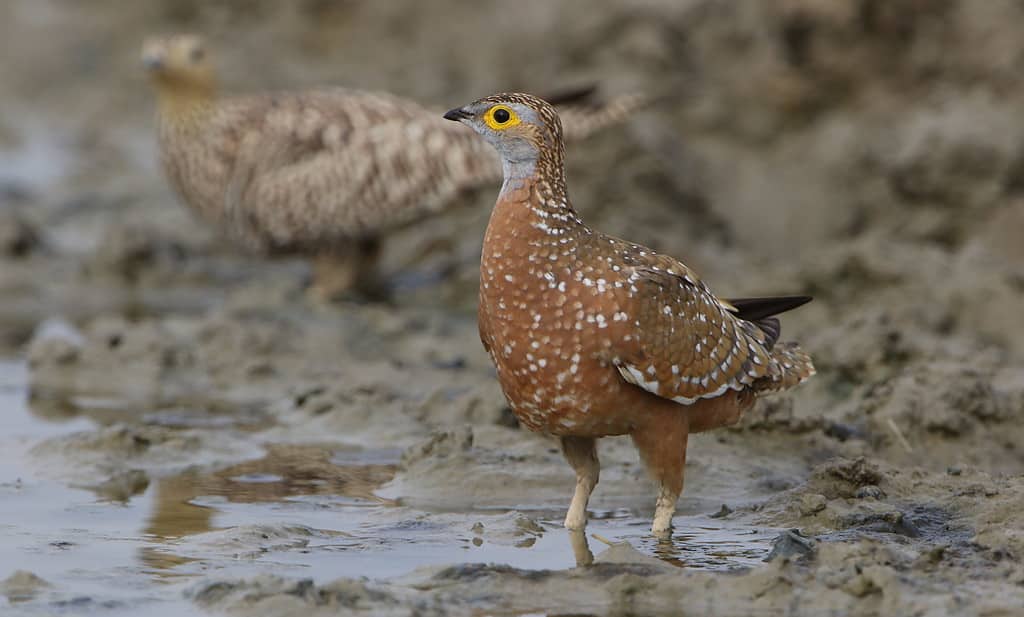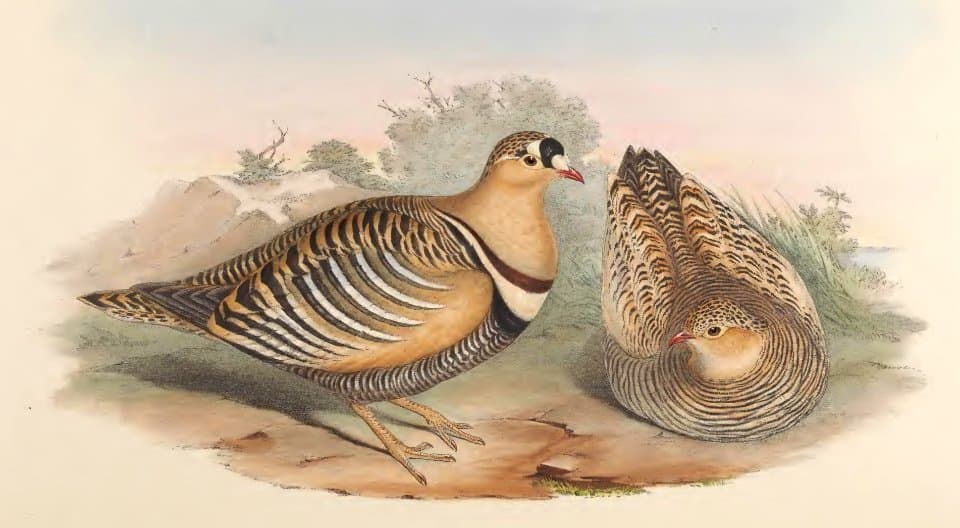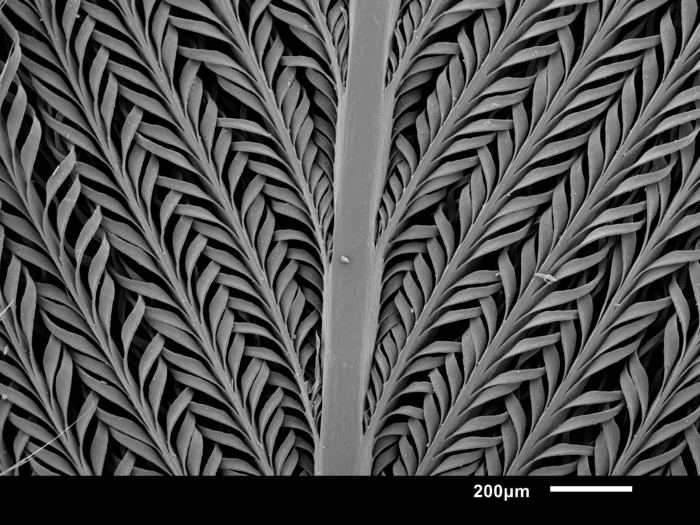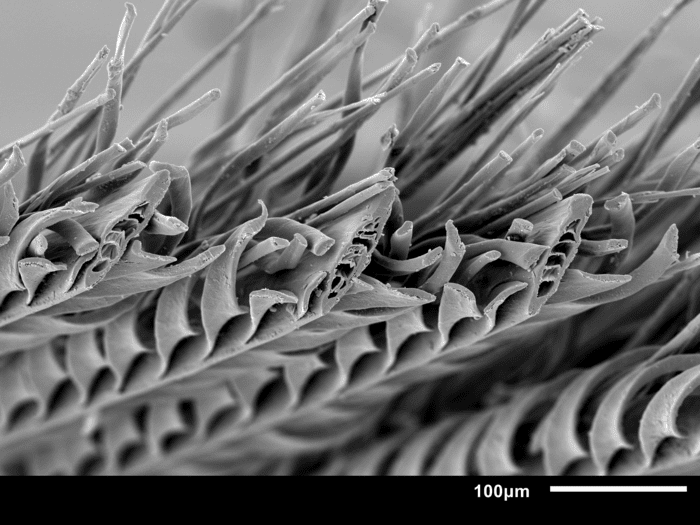
When you think of birds, feathers usually come to mind. This plumage covers the skin of birds, providing warmth and insulation, aiding in gender identification, attracting mates, and of course helping with flight.
In many birds, feathers can also provide a water-repelling barrier that prevents the bird from getting wet. Ducks, for instance, have a special gland located near their tails that oozes an oil with waterproofing effects.
Yet in some very rare instances, feathers can provide the opposite function. The sandgrouse, for instance, can hold water in its belly feathers, allowing it to carry water to its thirsty chicks or cool eggs over vast distances.
In a new study, researchers at the Johns Hopkins University and Massachusetts Institute of Technology (MIT) have used modern imaging technology to zoom in on this unique type of feather, explaining the mechanisms that allow the sandgrouse to soak up water like a sponge.
The sandgrouse feather’s uncanny ability to retain water could inspire a new class of absorbent material with a wide range of exciting applications, from capturing water from mist to high-tech water bottles that prevent annoying swinging and sloshing.
Belly feather flask

The sandgrouse is a small bird that belongs to the family Pteroclididae. There are 16 known species of sandgrouse in the world that are found across the deserts and arid habitats of Africa, the Middle East, southern Europe, and Asia, which are well adapted to the harsh conditions of these environments.
Sandgrouse have small, pigeon-like heads and necks and sturdy compact bodies, ranging in size from 24 cm to 40 cm in length and from 150 g to 500 g in weight. You can tell males apart from females due to them being slightly larger and more brightly colored.
Sandgrouse are monogamous and the parents share responsibilities around their nest. For instance, they share incubation duties, with males incubating at night while females perform this task during the day.
Their eggs hatch after around three weeks inside nests usually located in very arid locations, often tens of miles away from popular watering holes. This is to protect the vulnerable chicks from hungry predators, but it also leaves the young hatchlings thirsty.
This problem is solved by a special adaptation: belly feathers that are excellent at absorbing and retaining water. The adult sandgrouse, particularly males, will go to watering holes many miles away and return with water for their young. They can carry up to 15% of their body weight in one flight, which is more than enough for their small hatchlings.
How do these amazing birds do it? The outer feathers of virtually all birds have a branched structure in which barbs branch off the main shaft, with smaller barbules further branching off the barb shaft. But the barbules of sandgrouse belly feathers have a helical coil right where they branch off the barb shaft. When they get wet, these coils unwind, rotating the barbules out of the plane of the feather’s vane and preventing water droplets from falling off due to gravity.
This much had been known since the 1960s, but due to the limited technology of the time, scientists couldn’t measure the exact dimensions of the different tiny parts of the feathers that are much too small to be seen with the naked eye and even with optical microscopes.
Now, armed with advanced tools like scanning electron microscopy, microcomputed tomography, light microscopy, and 3D videography, Jochen Mueller, an assistant professor in Johns Hopkins’ Department of Civil and Systems Engineering, and MIT engineer Lorna J. Gibson zeroed in on the microstructure of the sandgrouse belly feathers with unprecedented detail.
A wet microscopic forest

For Professor Gibson, part mechanical engineer, part materials scientist, part bird lover, this research proved an excellent opportunity to do some fun fundamental science.
“I had read about the sandgrouse feathers in an ornithology textbook and was fascinated by how this worked. It’s so unusual – one thinks of water running off a duck’s back and the water repellency of feathers. And this is just the opposite. Materials scientists like me look at how material properties are related to the microscopic structure of the material. And so I thought that we could better understand how the sandgrouse feathers worked by looking at their microscopic structure. And, not surprisingly, I’m a birder, so this just seemed like a great project to me,” he told ZME Science.

The researchers zoomed in on the tiny feather shafts, each just a fraction of the width of a human hair, and the even tinier barbules. In order to mimic the sandgrouse’s water harvesting, the scientists painstakingly dunked dry feathers in water, pulled them out, and then re-submerged them in a glass tube. During all this time, the delicate feathers were magnified, revealing the full breadth of their intricate structure.
The analysis showed that individual feathers hold water thanks to a forest of barbules near the shaft and curled barbules near the tip that act like caps.
“Next to the main feather shaft, the barb shafts are relatively large, making them stiff enough that they remain relatively rigid and don’t deform under surface tension forces. The barbules, on the other hand, are much smaller; when wetted, they bend and surface tension forces draw them together into tear-drop-like structures that hold water. Further out from the main feather shaft, both the barb shafts and barbules are even smaller and wispier; they curl around the inner zone of the feather, further contributing to water retention,” Gibson said.

Harvesting water from fog
This entire research started out as a curiosity-driven project done purely for the joy of doing science for the sake of it. “Feathers are so amazing!” Gibson, a true birdwatcher, told me with almost childlike glee.
However, this doesn’t mean there aren’t important potential applications of these new findings. Water scarcity is a growing problem with 2.3 billion people — or a quarter of the world’s population — living in water-stressed countries, with consequences that are disproportionately felt by the poorest and most vulnerable.
Only 3% of the world’s freshwater is accessible, with the rest frozen in glaciers or otherwise unavailable to us, and the pressure felt due to water scarcity is only amplified by climate change.
Clearly, we can use all the help we can get, and I think we can learn a thing or two from a species that has adapted to some of the world’s most arid habitats.
Although Gibson and Mueller don’t have plans for commercial applications of their own in mind, they believe the sandgrouse’s belly feather structure could be adapted into artificial materials that can harvest humidity in the atmosphere, literally making water out of thin air.
Another interesting potential application includes mimicking the sandgrouse feather structure inside the inner design of water bottles and sports backpacks. Such a water bottle could hold a lot of liquid without it swishing around while a person moves, the kind of product that runners could particularly find appealing.
“It’s awe-inspiring to think that evolution could produce this solution for transporting water to chicks at the nest in the desert,” Gibson said.
The findings appeared in the journal Interface.


